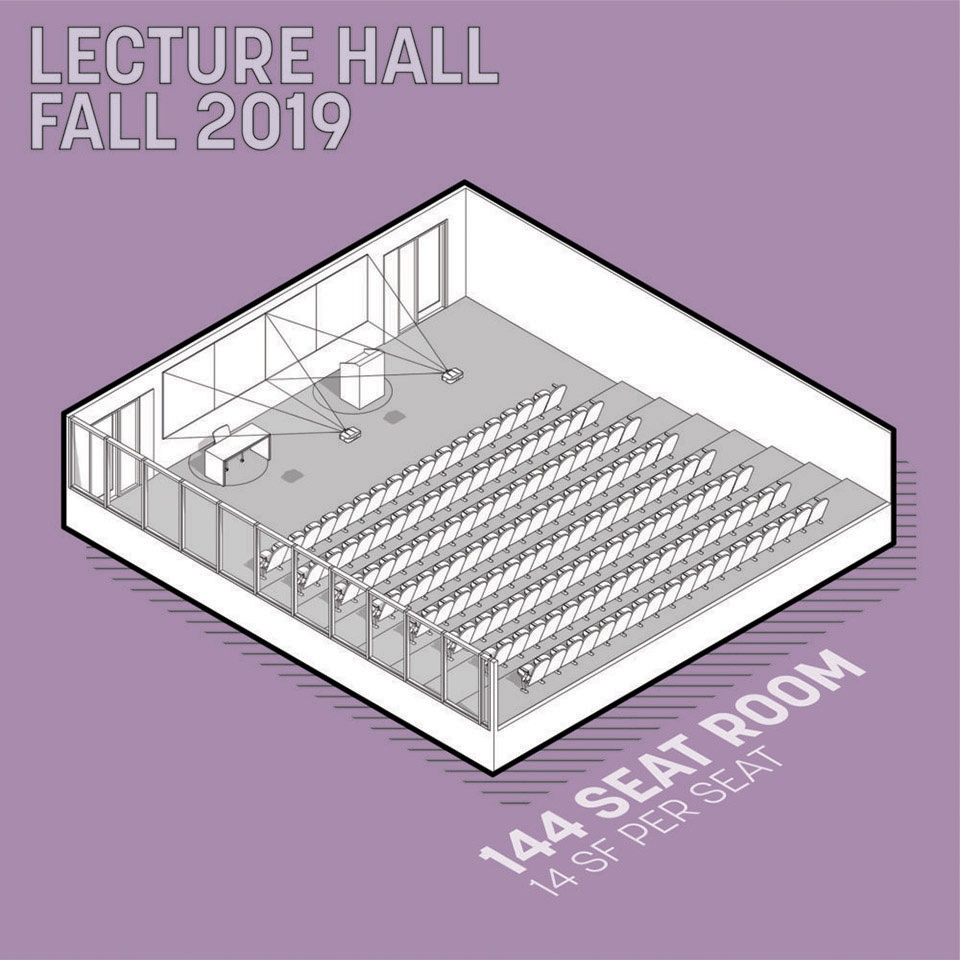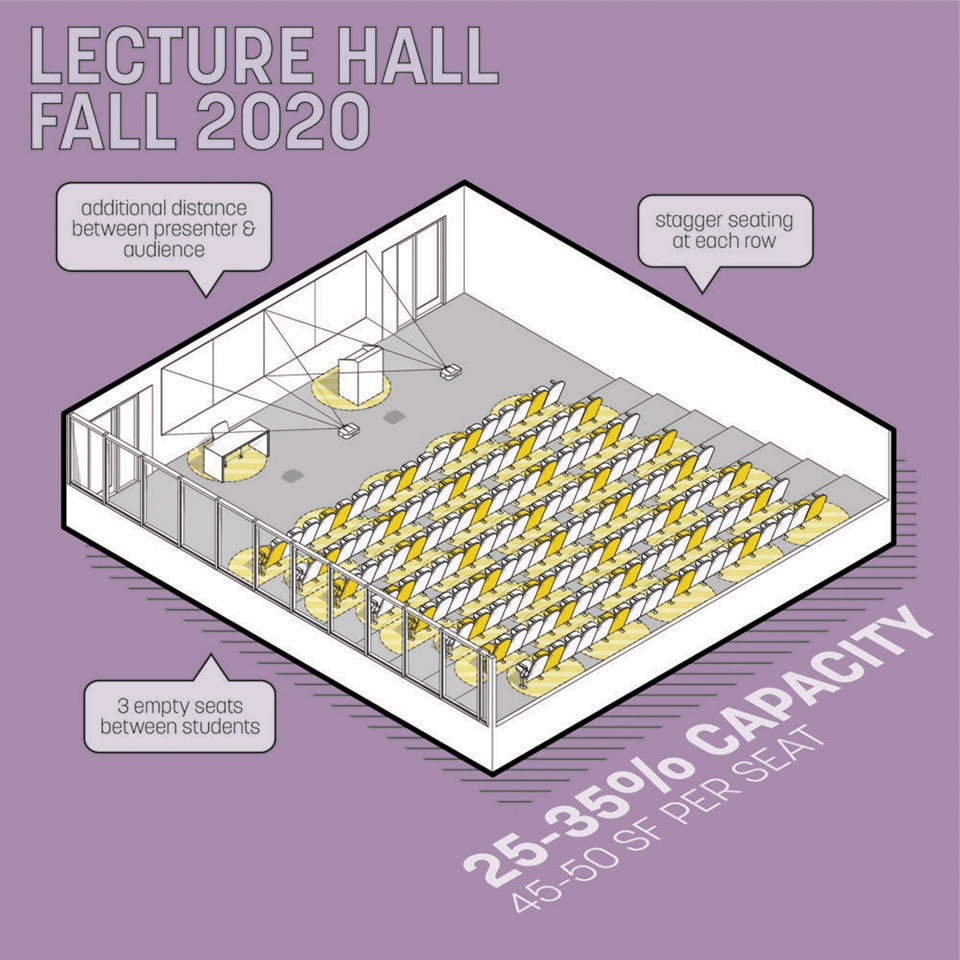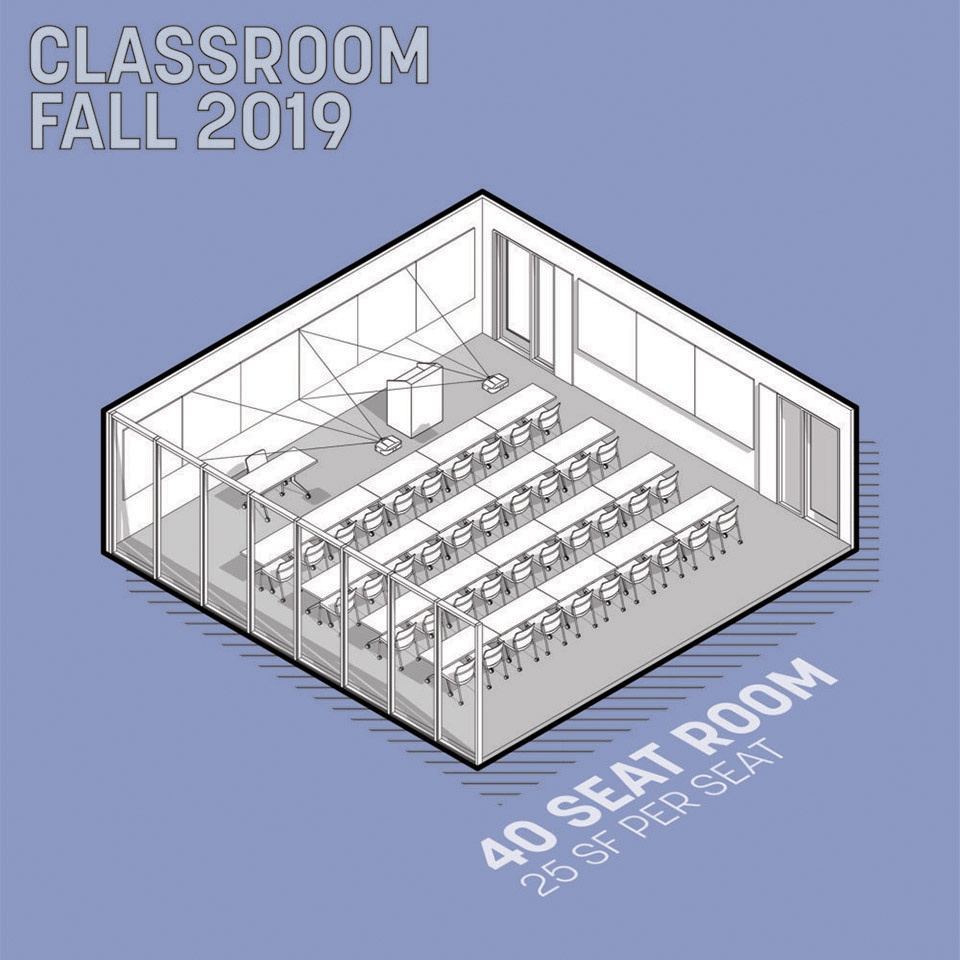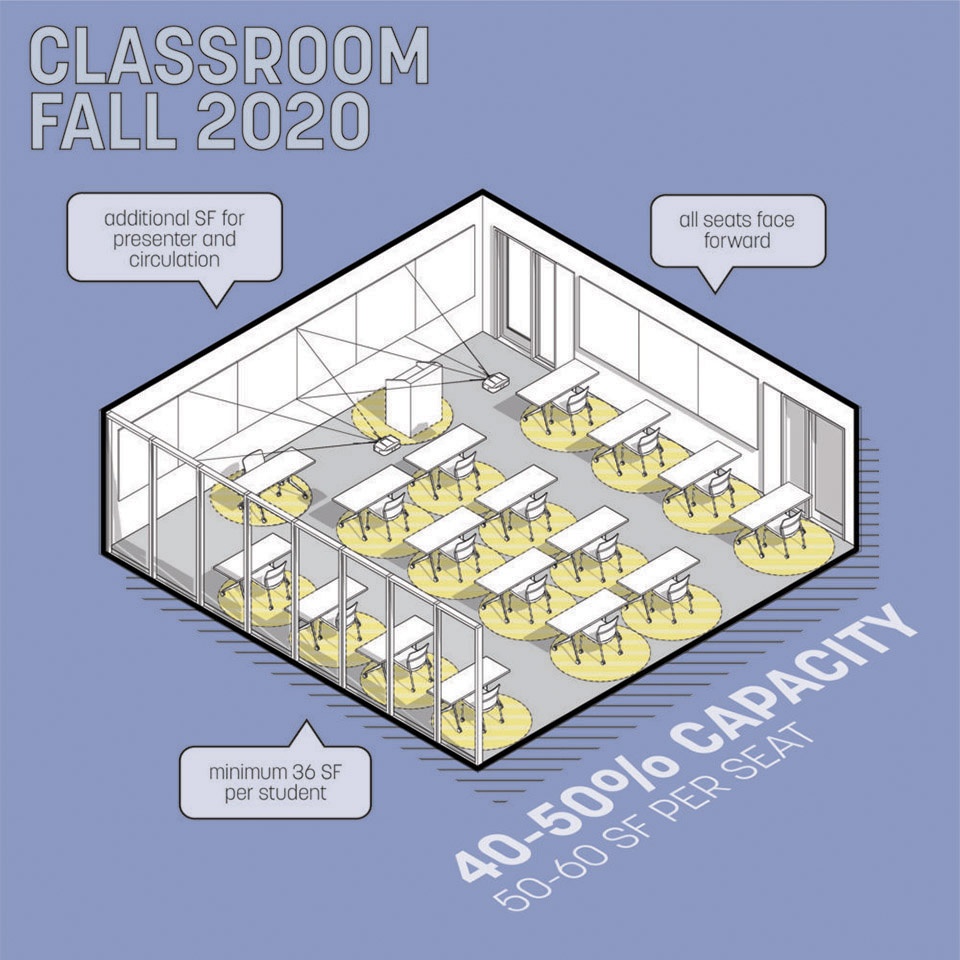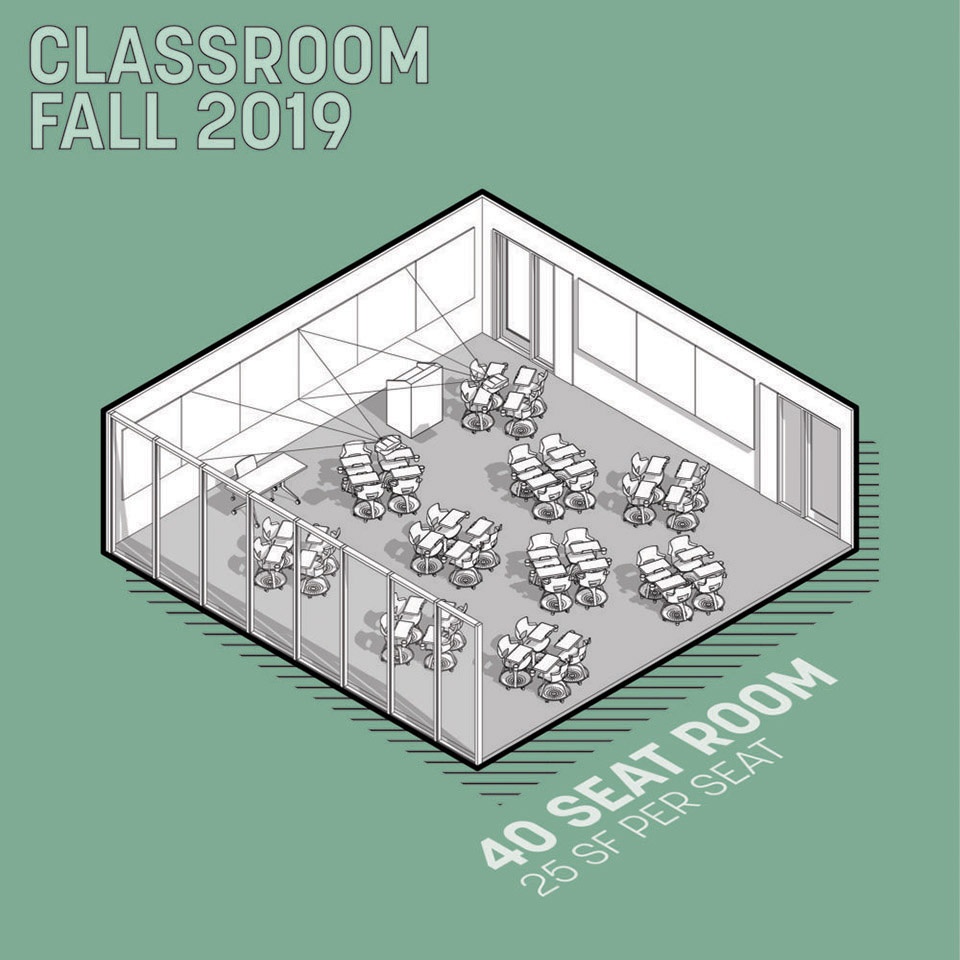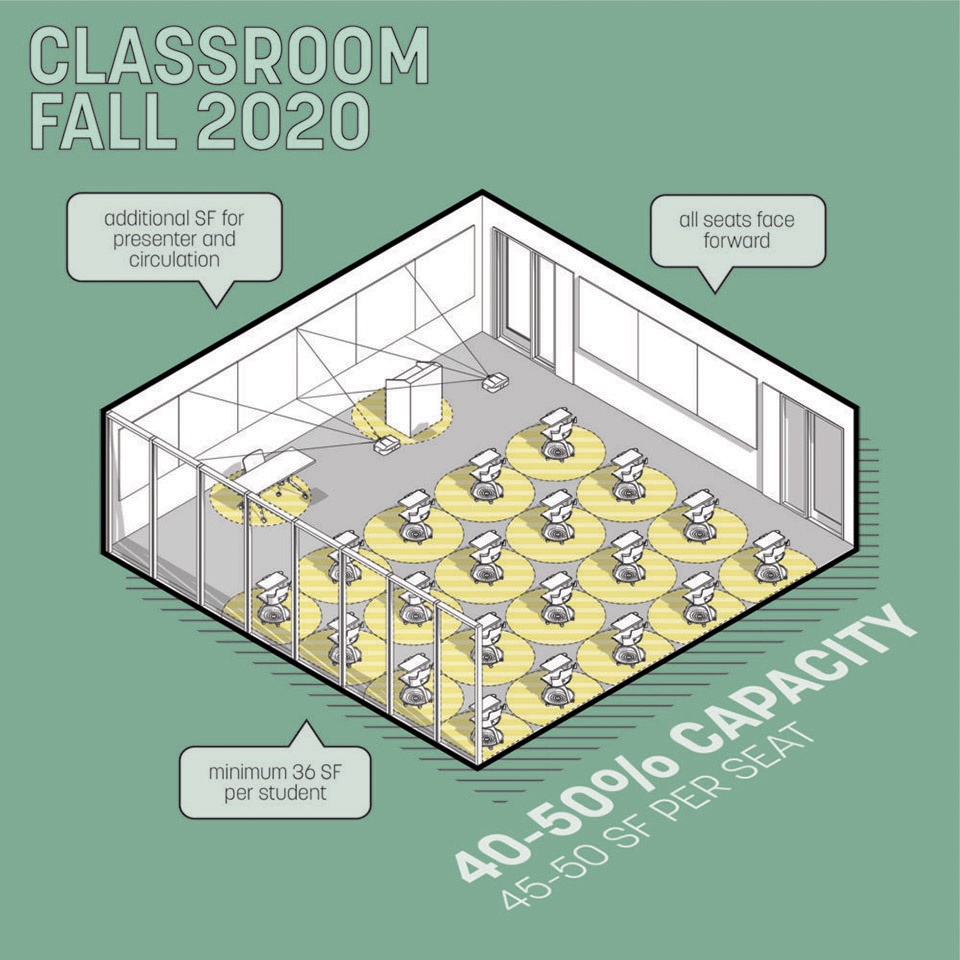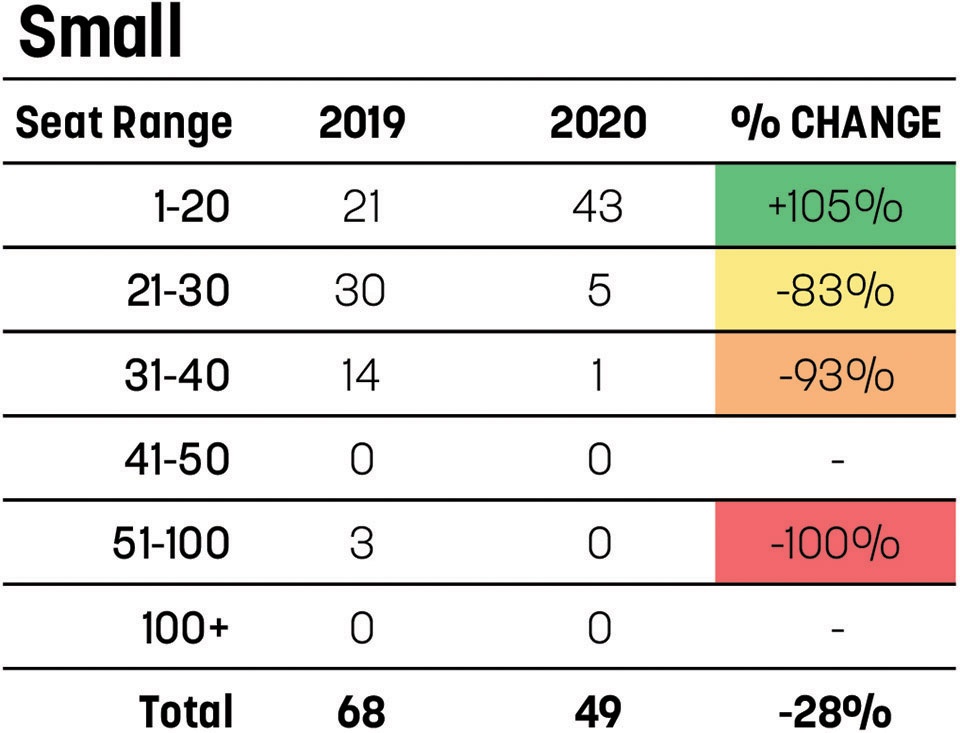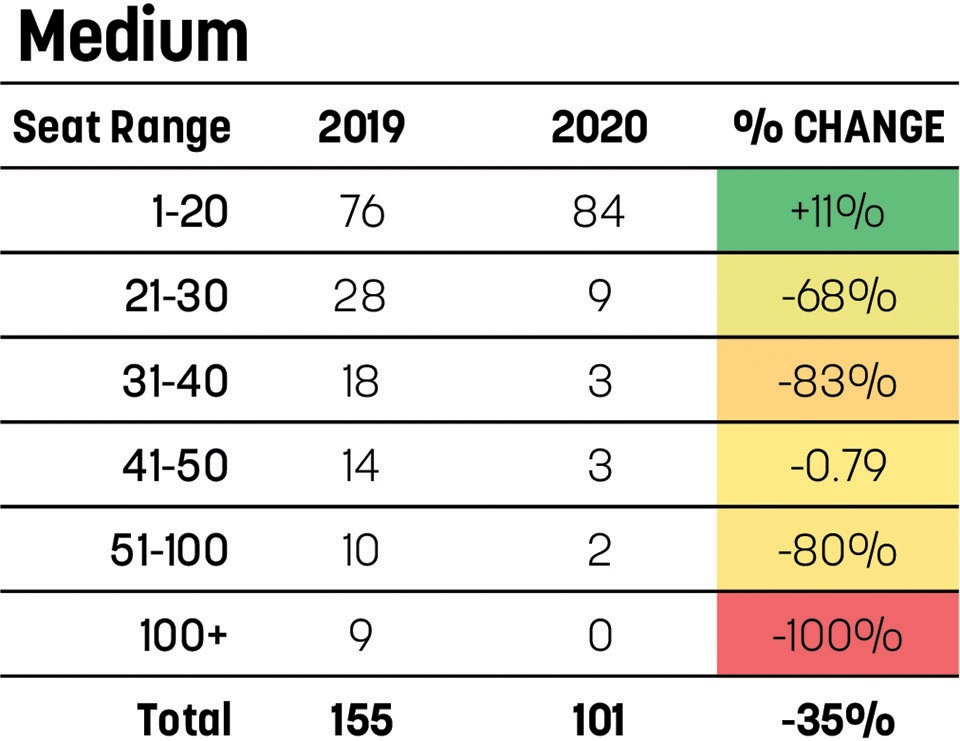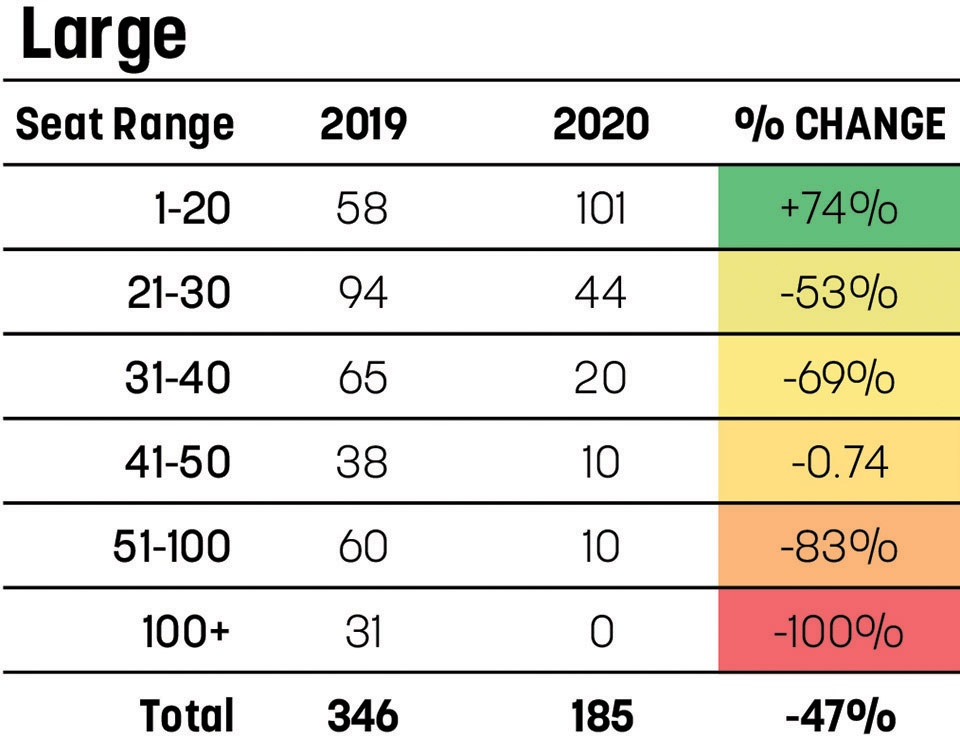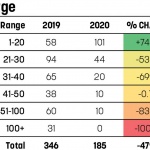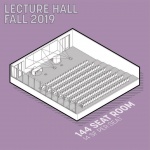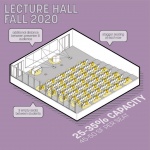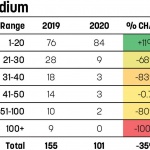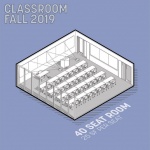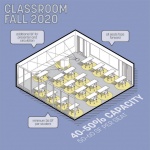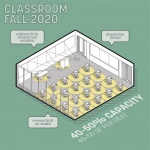来自Sasaki 对gooood的分享。更多请至:Sasaki on gooood
Appreciation towards Sasaki for providing the following description:
背景
Background
新冠肺炎彻底颠覆了高等教育的世界。今年,当我们还在一直讨论线上教学是否可能取代现行普遍的线下教学,而它就一夜成真了!尽管我们竭尽所能通过Zoom(网络会议软件)和其他在线平台提高学习的创造性与参与度,许多学生和教师仍然渴望着回归到实体教室。在这之后,还有人会抱怨早上8点或周五的课吗?
布朗大学校长克里斯蒂娜-帕克森(Christina Paxon)在她最近的专栏文章中谈到了这种渴望,她说:”学生们仍然需要从面对面的教育环境中学习:激烈的知识辩论在Zoom上难以为继,实验室和图书馆提供了更好的研究机会,与拥有不同观点和生活经历的学生互动也是线上教学所无法体验的。”即便我们终将回归校园,可想而知的是,近期内教育的面貌将大不相同。
在1960年代之前,绝大多数的教室里,学生们都坐在分隔的单人课桌前,或者是分层的阶梯教室并面向讲台。当时的班级规模也大得多,单个座位的空间远小于今天的标准。但是自1970年代以来,教学空间设计更加强调小班教学及主动式学习(active learning),同时为单人座位提供了更多空间,以促进动手实践课程(hands-on-activity)和项目式学习(project-based learning)。这样的教学设计方式,在新冠肺炎所带来的诸多考虑下,既是机遇也是挑战。
教室分散化的趋势与保持社交距离的目标一致,但目前的教室标准还远低于社交距离的要求。社交距离规范建议人与人之间在各个方向至少保持6英尺(2米)的距离,这相当于每人需要36平方英尺(约3.4平米)。然而一旦纳入对动线空间需求等因素的考虑,空间需求将更大,超过每个座位25-35平方英尺(约2.3-3.3平米)的典型“主动式学习”空间标准。此外,社交距离规范还建议课桌应该统一朝向,而不是面对面,以减少病毒的飞沫传播,这直接与“项目式学习”的原意相悖,并不鼓励学生在教室中一同就坐,协同工作,甚至面对面进行研讨。
COVID-19 has turned the world of higher education upside down. After years of wondering if online learning would ever upend place-based learning, it suddenly did…literally overnight! Yet, for all the creativity and engagement we’ve managed to squeeze out of Zoom and other online platforms, many students and faculty long for a return to the physical classroom. Will anyone ever complain about an 8:00 a.m. or Friday class again?
In her recent op-ed, Brown University President Christina Paxon addressed this yearning by saying “…students will still benefit from all that makes in-person education so valuable: the fierce intellectual debates that just aren’t the same on Zoom, the research opportunities in university laboratories and libraries, and the personal interaction among students with different perspectives and life experiences.” Yet even if a return to campus is inevitable, we can all recognize it will look quite different, at least in the near term.
In the 1960s and prior, the preponderance of classrooms had students seated at individual desks, spaced apart, or in lecture halls with seats separated by tiers and all facing the same direction. Class sizes were much larger and space per seat much less than today’s standards. But since the 1970s, learning space design has emphasized smaller section cohorts, active learning, and more space per seat to enable hands-on-activity and project-based learning. This approach presents both an opportunity and a challenge amid COVID-19 concerns.
The trend of general classroom de-densification aligns with social distance requirements, yet current classroom standards do not go far enough. Social distancing suggests a minimum of six feet of separation between individuals in all directions. This equates to 36 square feet per person, however it does not account for things like circulation, which will only increase this space demand above the typical active learning space standards of 25-35 square feet per seat. Moreover, social distancing suggests that desks should all be turned in the same direction, rather than facing each other, to reduce transmission from virus-containing droplets. This, of course, directly contradicts the intent behind project-based learning whereby students sit and work together in the classroom, or even seminar-style discussions that favor face-to-face discourse.
调研
Research
为了理解对学习环境的可能影响,以及考虑院校如何调整今年秋季的学习环境,我们深入研究了院校数据库。我们通过研究各类典型教室,界定了对一般教室和演讲厅进行调整的方法,以应对社交距离的规范。
以演讲厅为例,一个144人的典型演讲厅每个座位的平均面积为14平方英尺(约1.3平米),如果每排错开并间隔三个空位,那么它的总容量只能维持25-35%。这样每个座位的空间增加了三倍,约40-50平方英尺(约3.7-4.6平米)。同时,一个典型的40人教室,每个座位平均面积25平方英尺(约2.3平米),在重新布置降低密度以满足新冠肺炎期间的规范时,只能保留40-50%的容量。
In order to understand the impacts on learning environments, as well as consider how institutions might adapt their learning environments for the fall semester, we took a deep dive into our institutional database. When we examine a range of classroom prototypes, we can identify how adjustments to general use classrooms and lecture halls can be made to accommodate social distancing requirements:
In the case of a lecture hall, a prototypical 144-seat room with an average of 14 square feet per seat would maintain only 25-35 percent of its total capacity if you were to stagger seating at each row and leave three empty seats between students. This approach would result in triple the amount of space per seat, roughly 40-50 square feet. Meanwhile, a typical 40-seat flat-floor classroom with 25 square feet per seat could expect to retain only 40-50 percent of its capacity when rearranging and de-densifying to meet COVID-19 requirements.
▼演讲厅空间模型,model of lecture hall ©Sasaki
▼普通教室空间模型,model of classroom ©Sasaki
为了理解各策略对校园教室容量的潜在影响,我们从数据库中选取了大、中、小三所不同规模的院校进行研究。我们发现在不同规模的教室类型中,策略所带来的影响是有差异的,然而,对于51人以上教室,所有院校都损失了80-100%的容量,即便在31-40人的范围内,这三所院校也都损失了69-93%的教室容量。总的来说,我们的研究结果说明,由于教室面积的限制,各规模院校都需暂时以更小的班级为单位进行面授课程。
To understand the potential impact of individual strategies on an entire campus’s classroom inventory, we examined three different-sized institutions – small, medium, and large – from our database. When we examine specific size cohorts of classrooms, we find considerable variability; however, all of these institutions consistently lost 80-100 percent of their classrooms that seat over 51 students. Even in the 31-40-seat range, all three institutions lost between 69 and 93 percent of these rooms. In general, the findings from our study sample suggest that institutions of all sizes will temporarily need to conduct in-person classes in much smaller cohorts due to classroom size constraints.
▼调查统计,research statistics ©Sasaki
启示
Inspiration
本案例研究中所概述的方法适用于各院校在筹备秋季或春季学期恢复线下教学所需的准备工作。教学空间也需要采用固定座位的方式来布置,原先灵活的空间需要重新配置家具或移除家具以符合密度要求;对于固定座位的空间,需要根据社交距离规范将椅子隔开。当然,在进行这些物理上的改变的同时,管理方面也需配合变革,如更频繁的清洁、增加排课空档窗口、错开上下课时间以避免过度拥挤等。最后,若能发挥创意将校园其他空间,如食堂、会议中心、活动空间等改造成临时教室,也有助于解决眼前的空间需求。
这些对教室的短期改变将帮助我们解决保持社交距离的空间需求,但是它可能无法满足具体的教学需求,当然,这些决定都会因院校和教师而异。而可以肯定的是,在这些条件下,项目式学习和实践性的团队学习将很难在课堂环境下进行。我们需要对线上平台寄予更多的期望,以实现课堂外的探索与合作。这样一来,“翻转课堂”的概念可能会暂时被“翻回”,也就是说,在不久的将来,讲座式的教学可能更多会于线下进行,而协作学习可能需要更多网络创新的支持。
虽然我们不得不重新配置教室、审视教学方法和校园运营,但以积极的态度来看,新冠病毒的全球肆虐提供了快速实验和创新的机会。当然最好的情况是我们都可以尽快回到面对面的交流,但在逐步恢复的道路上,我们在保持社交距离的同时也许可以进行一些前瞻性的实验,以支持健康且具有韧性的未来。
These approaches outlined in this case study tracks with the work that many institutions will need to do if they are considering a return to place-based instruction in the fall or spring. Instructional spaces will need to be sorted based on fixed versus flexible seating arrangements. For rooms with flexible seating, furniture will need to be reconfigured and, likely, removed to align with density requirements. For fixed-seat spaces, chairs will need to be cordoned off in accordance with spacing guidelines. Of course, these physical changes will need to be accompanied by operational changes such as more frequent cleaning, increasing scheduling windows, and staggering class arrival and departure times to avoid overcrowding. Finally, creative adaptation of other campus spaces such as dining halls, conference centers, and event spaces into temporary classrooms can also help solve for immediate space needs.
These near-term changes to classrooms will help us address the physical requirements of social distancing, but they don’t totally solve for how we are teaching in these environments. Of course, those decisions will be up to the individual institutions and faculty. However, it does seem safe to conclude that project-based, hands-on team learning will be difficult to do in a classroom setting under these conditions. We will need to continue to expect more from online platforms to enable out-of-classroom exploration and collaboration. In this way, the notion of the “flipped classroom” may be temporarily “un-flipped.” That is, in the near term, didactic learning might be more place-based with collaborative learning happening via innovations in the online.
While it’s daunting to have to reconfigure classrooms and reexamine pedagogy and campus operations, in the best light this pandemic offers an opportunity for rapid experimentation and innovation. The hope is that all of us can return to face-to-face interaction soon, but in the time it takes to get there, perhaps we can practice both social distancing and forward-looking experimentation to support healthy, resilient futures.
作者:Tyler Patrick ; Robert Sugar
More: Sasaki 更多关于他们:Sasaki on gooood.

